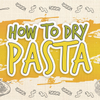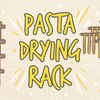How To Dry Pasta

Pasta Drying: An Overview
The pasta drying process removes the moisture content in fresh pasta so that it can retain its shape and increase its longevity during storage. Ideally, pasta drying should be conducted on a pasta drying rack, after which the now dry pasta strands get sealed in an airtight container and moved into storage for up to 3 months. This guide will take you through everything there is to know regarding pasta, how to dry it, and any considerations you need to be aware of before drying your pasta.
What Is Pasta Drying?
The pasta drying process removes the moisture content in fresh pasta so that it can retain its shape and increase its longevity during storage. Ideally, pasta drying should be conducted on a pasta drying rack, after which the now dry pasta strands get sealed in an airtight container and moved into storage for up to 3 months.
Further reading material: kingarthurbaking.com
Why Dry Pasta?
1. Maintaining Required Shape
The drying process reduces the amount of moisture trapped in the fresh pasta allowing the dough to retain the set shape such as thin strands. The process also draws out the gluten molecules near the surface of the pasta strands, when cooked gluten tends to become more sticky and springy - as a result, the pasta strands have a firmer shape with a tender texture.
2. Prevent Contamination
Eliminating the moisture content in fresh pasta will reduce the probability of contamination occurring during storage. This is because most bacteria and yeast cultures that invade fresh pasta do require a moist environment to thrive. Eliminating this condition will leave you with fresh pasta strands that can be stored for a more extended period without developing any mold and other harmful contaminants.
3. Increase Shelf Life
Dried fresh pasta can be stored for up to 3 months in a cold, dry place. This is due to the reduction of moisture content in the pasta, which effectively eliminates all microbial activity within the pasta allowing the food to be stored in airtight containers for long-term use. The reason why you need airtight storage containers or ziplock bags to store your dried pasta is to avoid the reintroduction of harmful cultures that are freely floating in the air at any given time.
4. Adding Unique Taste And Texture
Drying fresh pasta gets rid of all that moisture leaving you with dry pasta strands that have a unique taste and a crunchy texture that gets firm and absorbent after the dried pasta is cooked, allowing it to absorb pasta sauce. The pasta drying process leaves behind a layer of gluten on the surface of the pasta strands, which adheres to the pasta sauce while maintaining the shape of the pasta instead of ending up with crumps of pasta and sauce.
Further reading material: recipetips.com
Considerations Before Drying Pasta
1. Amount Of Pasta To Be Dried
The amount of pasta to be dried will dictate which method is best used to dry the fresh pasta. When dealing with small amounts of fresh pasta dough, you can rely on the ambient temperature to dry the fresh pasta strands instead of investing in a commercial dryer. On the other hand, when dealing with large quantities of fresh pasta, you will need to consider getting a commercial pasta drying rack or better yet, an automated pasta drying machine. These can monitor the pasta drying rate to ensure that each strand meets the required moisture level for long-term storage. This also reduces the number of cracked end products which would just translate to additional loss.
2. Available Drying Equipments
Before getting started with the pasta drying process, it's recommended to take stock of available pasta drying equipment. If you have a pasta drying rack, make sure it has enough space to dry all of the pasta strands you intend to produce. This prevents the mix up that often arises when fresh pasta strands are dried at different times resulting in some strands becoming too dry and developing tiny hairline cracks. While under-drying the strands results in increased cracking and stresses the strands making most of them to break during storage.
3. Required Level Of Firmness
Different pasta varieties require different levels of firmness, which is influenced by the drying rate. This is because as the fresh pasta strands get exposed to hot air, the outermost layer will begin to harden first, and the moisture elimination process will go on until the pasta achieves a consistent level of dryness. This will, in turn, determine how fast or slow the pasta absorbs sauce after cooking depending on the level of firmness.
4. Available Packaging Material
Before you start drying fresh pasta, it's recommended to prepare the packaging material beforehand and confirm that the specific length of pasta strands you want to work with can actually fit in the storage container. This will eliminate the need to break long strands that fail to fit in the storage container or end up overstuffing a single container with all that dry pasta as the extra pressure might cause air to leak into the storage container- which would only introduce contaminants to the stored pasta.
Equipment Required To Dry Pasta
1. Pasta Drying Rack/ Preferred Drying Equipment

A pasta drying rack is a specially designed equipment that's mostly wooden or metallic with long arms attached to a central stand with a firm base. The long thin arms hold the fresh pasta strands which are draped on it to dry naturally. Alternatively you can choose to use any other equipment that's available in the kitchen and can get the job done such as dehydrators, or convection ovens.
2. Large Kitchen Tray
Having a large tray on stand by will make it much easier to keep your pasta strands organized as they cool to room temperature before being sealed in storage containers.
3. Airtight Storage Containers
In order to retain its freshness and texture, dry pasta needs to be stored under strictly airtight conditions hence the need to use airtight containers or ziplock bags. Airtight food storage containers are often equipped with a pump and airlock to pump out as much air as possible or alternatively you can use a vacuum pump.
How Long To Dry Pasta For & Recommended Drying Method
Further reading material: link
|
Pasta Variety |
How Long To Dry |
Recommended Drying Method |
|
For Fresh Cooking |
15 minutes |
Pasta drying rack |
|
For Fridge Storage |
2 to 4 hours |
dehydrator |
|
For Freezing |
8 to 12 hours |
dehydrator |
|
For Long Term Storage |
8 to 12 hours |
Pasta drying rack |
For Fresh Cooking
How Long: 15 minutes
Recommended Drying Method: Pasta Drying Rack
Fresh pasta strands can be cooked directly after the extrusion process or allowed to dry for a short period of time - usually not more than 15 minutes before being cooked. Only use salted boiling water to cook fresh pasta as the immediate exposure to boiling water will give the pasta a layer of sticky gluten to help keep the strands in shape.
For Fridge Storage
How Long: 2 to 4 hours
Recommended Drying Method: dehydrator
Fresh pasta can only be stored in the fridge for around 3 to 5 days, after which it will have to be consumed or moved into long term storage. Fresh pasta that's meant for fridge storage should be dried using a dehydrator for up to 4 hours to reduce the moisture content of the pasta strands allowing them to remain firm even after storage.
For Freezing
How Long: 8 to 12 hours
Recommended Drying Method: dehydrator
Fresh pasta can be kept frozen for up to 3 months. However, before freezing the pasta, you will need to get rid of most of the moisture in the strands. This is best achieved using a dehydrator whereby the pasta strands are allowed to dry for at least 8 to 12 hours in the dehydrator. This eliminates the moisture content which would otherwise freeze into ice crystals and destroy the texture of the fresh pasta.
For Long Term Storage
How Long: 12- 24 hours
Recommended Drying Method: pasta drying rack
Fresh pasta can be dried and kept in an airtight container for up to 3 months. The pasta will undoubtedly require a more extended drying period in order to remove as much moisture as possible, which is best achieved by hanging the fresh pasta strands on a pasta drying rack.
Methods For Drying Pasta
- Pasta Drying Rack
Overview
A pasta drying rack refers to any specially designed tool with flat thin surfaces that allow pasta strands to be hung on while they dry. Pasta drying racks vary in size, design, and materials used. As a result, there’s a rack for every pasta variety, allowing the individual strands to dry without sticking together and retaining the required pasta shape.
Recommended Storage Method After Dehydrating: in an airtight container
How Long Does It Last: up to 3 months
Detailed Method
How To Use A Pasta Drying Rack
- Gently drape the fresh pasta strands onto a pasta drying rack, taking care not to leave them touching. Having space between the ribbons prevents them from drying up while sticking to each other and also increases the airflow allowing the strands to dry much faster.
- Allow the pasta strands to dry to a brittle and crispy texture. Transfer the dry pasta strands into an airtight container and store at room temperature for up to 3 months in the pantry.
2. Dehydrator
Overview
A dehydrator relies on an electric heating element to heat up the air, which is then blown over the food by the fans. The hot air instantly heats up the water molecules on the surface of the food, and the vapor gets carried off by the blowing hot air currents. As a result, food gets dehydrated at a much faster and controllable rate without using too much heat, which might render the food inedible.
Recommended Storage Method After Dehydrating: vacuum-sealed in airtight containers for long term use
How Long Does It Last: up to 3 months
Detailed Method
- Place the pasta strands on the dehydrator mesh sheets. Alternatively, you can use lined trays to hold the pasta strands, ensuring that they are only one layer deep.
- Set the dehydrator to 135 °F/ 57 °C and dehydrate the pasta for at least 4 hours
-
Store the dried pasta strands in vacuum-sealed containers and store them in room temperature.
- Oven
Overview
You can use a convection oven to quickly dry your fresh pasta. A convection oven relies on a fan and exhaust system to push hot air over the baking food- in this case the strands of fresh pasta which quickly lose their moisture content to the hot air leaving them dry.
How Long Does It Last: up to 3 months
Detailed Method
- Lay the pasta strands on a large baking sheet taking care not to leave them touching.
- Place the baking sheet into the oven and set it to the minimum possible temperature while also leaving the oven opened.
- Bake the pasta strands for up to one 1 hour or until they achieve a yellowish hue and firm crunchy texture.
- Take out the baking sheet and allow the pasta strands to cool down to room temperature before sealing them in an airtight container in readiness for storage.
How To Store It Without Sticking Common Questions
Can You Dry Egg Pasta?
Yes, egg pasta can be dried on a baking sheet covered with wheat flour and allowed to dry on the countertop for at least 12 hours.
Do I need To Dry My Pasta Before Cooking?
No, fresh pasta can be cooked right after it's been extruded. However, if you intend to store the fresh pasta for long-term use, make sure that the strands are completely dried out.
How Long Does Fresh Dried Pasta Last?
Dried fresh pasta can be stored for up to 3 months in an airtight container.
How Do You Fix Dry Pasta?
Dry pasta can be fixed by sprinkling it with little amount of water or pasta water over the dry pasta before reheating it.
Can You Let Homemade Pasta Dry Overnight?
Yes, homemade fresh pasta can be dried overnight on a pasta drying rack.
Are Egg Noodles And Pasta The Same?
Egg noodles and pasta almost always follow the same recipe except when you don't need eggs in the pasta recipe. However, as a general rule; egg noodles have more egg content than pasta giving them a characteristic texture that allows them to adhere well with butter-based sauces and heavy cream sauces.
Can I Substitute Egg Noodles For Pasta?
Yes, you can substitute egg noodles with any ribbon-shaped pasta, such as fettuccine.
Do Egg Noodles Taste Like Pasta?
Somewhat- egg noodles have a richer flavor compared to pasta with additional hints of savory notes thanks to the additional egg content.
How Much Water Does Dried Pasta Absorb?
Dried pasta absorbs at least 1.4 times its own weight in water during the cooking process.






